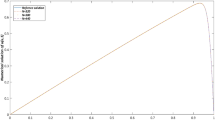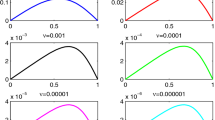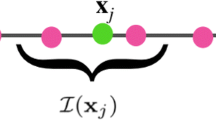Abstract
A meshless method is presented to numerically study an interface problem between a flow in a porous medium governed by Darcy equations and a fluid flow, governed by Stokes equations. In fact, the domain of the problem has two parts, one governed by Stokes equations and the another governed by Darcy law. Governing equations on these two parts are mutually coupled by interface conditions. The approximation solution is based on local radial basis function–finite-difference (RBF–FD) which is carried out within a small influence domain instead of a global one. By this strategy, the final linear system is more sparse and well posed than the global one. Several numerical results are provided to illustrate the good performance of the proposed scheme.












Similar content being viewed by others
References
Camano J, Gatica GN, Oyarzúa R, Ruiz-Baier R, Venegas P (2015) New fully-mixed finite element methods for the Stokes–Darcy coupling. Comput Methods Appl Mech Eng 295:362–395
Cao Y, Gunzburger M, Hu X, Hua F, Wang X, Zhao W (2010) Finite element approximations for Stokes–Darcy flow with Beavers–Joseph interface conditions. SIAM J Numer Anal 47(6):4239–4256
Chidyagwai P, Rivière B (2010) Numerical modelling of coupled surface and subsurface flow systems. Adv Water Resour 33(1):92–105
Vassilev D, Wang C, Yotov I (2014) Domain decomposition for coupled Stokes and Darcy flows. Comput Methods Appl Mech Eng 268:264–283
Hanspal N, Waghode A, Nassehi V, Wakeman R (2006) Numerical analysis of coupled Stokes/ Darcy flows in industrial filtrations. Transp Porous Media 64(1):73
Li R, Li J, He X, Chen Z (2018) A stabilized finite volume element method for a coupled Stokes–Darcy problem. Appl Numer Math 133:2–24
Li R, Gao Y, Li J, Chen Z (2018) A weak Galerkin finite element method for a coupled Stokes–Darcy problem on general meshes. J Comput Appl Math 334:111–127
Shivanian E, Jafarabadi A (2018) Rayleigh–Stokes problem for a heated generalized second grade fluid with fractional derivatives: a stable scheme based on spectral meshless radial point interpolation. Eng. Comput. 34(1):77–90
Rad JA, Rashedi K, Parand K, Adibi H (2017) The meshfree strong form methods for solving one dimensional inverse Cauchy–Stefan problem. Eng. Comput. 33(3):547–571
Shirzadi A (2012) Meshless local integral equations formulation for the 2D convection-diffusion equations with a nonlocal boundary condition. CMES Comput Model Eng Sci 85(1):45–63
Sladek J, Sladek V, Krivacek J, Wen P, Zhang C (2007) Meshless local Petrov–Galerkin ( MLPG) method for Reissner–Mindlin plates under dynamic load. Comput Methods Appl Mech Eng 196(25):2681–2691
Assari P, Dehghan M (2017) The numerical solution of two-dimensional logarithmic integral equations on normal domains using radial basis functions with polynomial precision. Eng Comput 33(4):853–870
Ghehsareh HR, Zaghian A, Raei M (2018) A local weak form meshless method to simulate a variable order time-fractional mobile-immobile transport model. Eng Anal Bound Elements 90:63–75
Shivanian E (2016) Local integration of population dynamics via moving least squares approximation. Eng Comput 32(2):331–342
Azarnavid B, Parand K, Abbasbandy S (2018) An iterative kernel based method for fourth order nonlinear equation with nonlinear boundary condition. Commun Nonlinear Sci Numer Simul 59:544–552
Abbasbandy S, Ghehsareh HR, Hashim I (2013) A meshfree method for the solution of two-dimensional cubic nonlinear schrödinger equation. Eng Anal Bound Elements 37(6):885–898
Fadaei Y, Moghadam MM (2017) A greedy sparse meshless method for solving heat conduction problems. Eng Comput 33(3):631–645
Davydov O, Schaback R (2016) Error bounds for kernel-based numerical differentiation. Numer Math 132(2):243–269
Sladek V, Sladek J, Shirzadi A (2015) The local integral equation method for pattern formation simulations in reaction-diffusion systems. Eng Anal Bound Elements 50:329–340
Assari P (2019) On the numerical solution of two-dimensional integral equations using a meshless local discrete Galerkin scheme with error analysis. Eng Comput 35(3):893–916
Shirzadi A, Ling L (2013) Convergent overdetermined-RBF-MLPG for solving second order elliptic PDEs. Adv Appl Math Mech 5(1):78–89
Assari P, Dehghan M (2019) Application of dual-Chebyshev wavelets for the numerical solution of boundary integral equations with logarithmic singular kernels. Eng Comput 35(1):175–190
Dehghan M, Abbaszadeh M (2017) A local meshless method for solving multi-dimensional vlasov–poisson and vlasov–poisson–fokker–planck systems arising in plasma physics. Eng Comput 33(4):961–981
Pouria Assari MD (2017) A meshless method for the numerical solution of nonlinear weakly singular integral equations using radial basis functions. Eur Phys J Plus 132(5):1
Sarra SA, Cogar S (2017) An examination of evaluation algorithms for the RBF method. Eng Anal Bound Elements 75:36–45
Yao G, Šarler B et al (2012) Assessment of global and local meshless methods based on collocation with radial basis functions for parabolic partial differential equations in three dimensions. Eng Anal Bound Elements 36(11):1640–1648
Safarpoor M, Shirzadi A (2019) A localized rbf-mlpg method for numerical study of heat and mass transfer equations in elliptic fins. Eng Anal Bound Elements 98:35–45
Shu C, Ding H, Yeo KS (2003) Local radial basis function-based differential quadrature method and its application to solve two-dimensional incompressible Navier–Stokes equations. Comput Methods Appl Mech Eng 192:941–954
Zhang X, An X, Chen CS (2015) Local RBFs based collocation methods for unsteady Navier–Stokes equations. Adv Appl Math Mech 7(4):430–440
Shivanian E, Jafarabadi A (2018) Capillary formation in tumor angiogenesis through meshless weak and strong local radial point interpolation. Eng Comput 34(3):603–619
Ghehsareh HR, Zaghian A, Zabetzadeh SM (2018) The use of local radial point interpolation method for solving two-dimensional linear fractional cable equation. Neural Comput Appl 29(10):745–754
Karamali G, Dehghan M, Abbaszadeh M (2018) Numerical solution of a time-fractional PDE in the electroanalytical chemistry by a local meshless method. Eng Comput 1–14
Dehghan M, Abbaszadeh M (2017) Numerical investigation based on direct meshless local Petrov Galerkin (direct MLPG) method for solving generalized Zakharov system in one and two dimensions and generalized Gross–Pitaevskii equation. Eng Comput 33(4):983–996
Hosseini VR, Shivanian E, Chen W (2015) Local integration of 2-d fractional telegraph equation via local radial point interpolant approximation. Eur Phys J Plus 130(2):1
Assari P, Asadi-Mehregan F (2019) The approximate solution of charged particle motion equations in oscillating magnetic fields using the local multiquadrics collocation method. Eng Comput 1–18
Safarpoor M, Takhtabnoos F, Shirzadi A (2019) A localized rbf-mlpg method and its application to elliptic pdes. Eng Comput 1–13
Assari P, Asadi-Mehregan F (2019) Local radial basis function scheme for solving a class of fractional integro-differential equations based on the use of mixed integral equations. ZAMM-J Appl Math Mech/Zeitschrift für Angewandte Mathematik und Mechanik 99(8):e201800236
Davydov O, Oanh DT (2011) Adaptive meshless centres and RBF stencils for Poisson equation. J Comput Phys 230(2):287–304
Assari P, Asadi-Mehregan F (2019) Local multiquadric scheme for solving two-dimensional weakly singular hammerstein integral equations. Int J Numer Modell Electron Netw Dev Fields 32(1):e2488
Assari P, Asadi-Mehregan F, Dehghan M (2019) On the numerical solution of fredholm integral equations utilizing the local radial basis function method. Int J Comput Math 96(7):1416–1443
Leveque RJ, Li Z (1994) The immersed interface method for elliptic equations with discontinuous coefficients and singular sources. SIAM J Numer Anal 31(4):1019–1044
Wendland H (2004) Scattered data approximation, vol 17. Cambridge University Press, Cambridge
Fasshauer GE (2007) Meshfree approximation methods with MATLAB, vol 6. World Scientific, Singapore
Li R, Li J, Chen Z, Gao Y (2016) A stabilized finite element method based on two local Gauss integrations for a coupled Stokes–Darcy problem. J Comput Appl Math 292:92–104
Acknowledgements
We would like to thank the referees for their valuable comments and helpful suggestions.
Author information
Authors and Affiliations
Corresponding author
Additional information
Publisher's Note
Springer Nature remains neutral with regard to jurisdictional claims in published maps and institutional affiliations.
Rights and permissions
About this article
Cite this article
Safarpoor, M., Shirzadi, A. Numerical investigation based on radial basis function–finite-difference (RBF–FD) method for solving the Stokes–Darcy equations. Engineering with Computers 37, 909–920 (2021). https://doi.org/10.1007/s00366-019-00863-5
Received:
Accepted:
Published:
Issue Date:
DOI: https://doi.org/10.1007/s00366-019-00863-5




